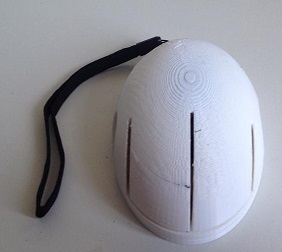
Verena Kuhr
Master Thesis Student
This email address is being protected from spambots. You need JavaScript enabled to view it.
Hello,
my name is Verena Kuhr and I am a graduated Master student at the RWTH Aachen University. My first contact with the HCI area was during my Proseminar at this chair in Summer 2010. Since then I took all courses this chair offers and learned a lot about how a design can be made as intuitive and usable as possible for everyday users.This helped me a lot during my bachelor thesis where I started a project called Framer to make personal fabrication more common in humans everyday life. After my Bachelor thesis, I startet to work as a student assistant in several research areas to get an overview of the different components in HCI.
My Master thesis dealt with the improvement of understanding statistical graphics.
After my graduation, I started to work at BSI Business Systems Integration Deutschland GmbH. If you have questions or want to contact me, you can send a mail to
Bachelor Thesis
Supervisor: René Bohne
Full text To read the whole thesis, you can download the PDF version.
Abstract This thesis introduces existing software for 3D object construction in a 2D environment as a result of the development of personal fabrication. With CAD software like OpenSCAD, the user creates new 3D objects. With 3D object creators like Makerbot Customizer, the user changes shapes and details of already existing objects. With 3D object libraries like Thingiverse, the user can upload and share his design with other people. The benefits and limitations of existing software are discussed, upon which a new software Framer is proposed.
The motivation to invent such a program like Framer and determined requirements are considered in a survey. The system and several iterations of the design are described, containing a user study with a paper prototype, all resulting in a usable program. The usability of Framer is outlined in a user study, which was conducted with a software containing the elements relevant to designing a 3D frame. The results indicate that Framer supports personal fabrication to be more common in humans everyday life and simplifies creating 3D frames together with printing them. This is evidence which supports the idea of designing such a program.
Main aspects and results
Framer: A Personal Design Tool for 3D Picture Frames
Master Thesis
Supervisor: Chat Wacharamanotham
In my Master's thesis I will design a system that helps improving the understanding of statistical charts with in situ simulation.
This will be an extension of the Statsplorer project, in which I focus on the analysis based on confidence intervals. As several related works already focussed on making CIs better understandable for experts, I want to focus on a way which guides the user through several representations of the data. When going through this process of reverse engineering also non experts in statistics shall understand the underlying data and therefore be able to interpret the given CIs. Furthermore, my work will distinguish from previous work, where the underlying data is needed as input. In my web based system it will only be necessary to upload the chart as an image. The underlying data gets simulated so that the user is able to get the necessary insight.
Full text Improving the understanding of statistical charts with in situ simulation
Abstract Statistical analysis plays an important role in evaluating and understanding the results of experiments. It lends evidence to claims made by readers who want to understand the outcome. However, several studies have indicated a lack of adequate statistical knowledge among researchers. Researchers have difficulties statistically analyzing charts of experiments found in papers. The reason for this is an inadequate statistical education and a misunderstanding of rules that can be applied when analyzing charts. As the visualization of data with uncertainty is vital for statistical analysis, but not easy to understand and interpret, several researchers tried to solve this problem. Existing data visualization software requires access to the data being visualized. Though, they are not helpful for the readers who do not have access to the underlying data.
As an attempt to solve these problems, we introduce SimCIs: an interactive visualization tool which simulates possible data underlying confidence interval graphs. The user uploads a paper with confidence interval (from now on abbreviated as CI) charts to SimCIs, to get it analyzed. The complexities of statistical analysis are lessened by embedding knowledge upfront. SimCIs also enables users to interact with visualizations and thereby improves the user’s ability to develop interests. According to our user study, we found that SimCIs helps users to be more confident when interpreting results correctly. The system also helps users to perform statistical analysis tasks correctly which they have not done before. In addition, SimCIs shows promise to be used as a learning tool, which can improve users’ statistical knowledge.
Student Assistant
Supervisor: Christian Corsten
According to Christians research area (interaction with everyday objects), my work includes the following components:
- Working with Pico-Projectors.
- Outlining different possibilities how everyday objects can be used.
- Coding an intuitive usable TV-control app.
Past Projects
- I tested the Aixplorer city guide as well as the Aixplorer Blog.

Aixplorer City Guide
- I developed and tested the FabMouse with others in a group as our MCP final project.
+
 +FabMouse
+FabMouse
Competences and Skills
- Good understanding of interface design.
- Good practices in developing and iterating projects and their design (from low fidelity prototypes until final running project).
- Good in testing big projects (like Aixplorer) according functionality and usability.
- Basic understanding of statistical data analysis.
- Fluent in German (native language) and in English. Basic knowledge in French.

